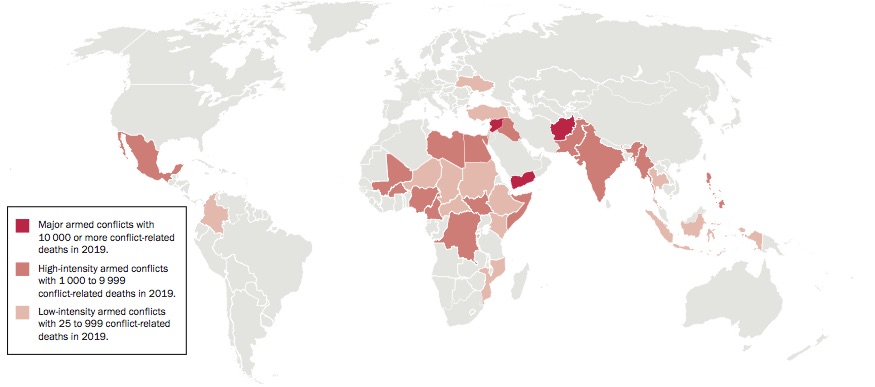2. Global developments in armed conflicts, peace processes and peace operations
Overview, Ian Davis and Jaïr van der Lijn [PDF]
I. Tracking armed conflicts and peace processes, Ian Davis [PDF]
II. Global and regional trends and developments in multilateral peace operations, Timo Smit, Sofía Sacks Ferrari and Jaïr van der Lijn [PDF]
III. Table of multilateral peace operations, 2019, Sofía Sacks Ferrari and Timo Smit [PDF]
Active armed conflicts occurred in at least 32 states in 2019: 2 in the Americas, 7 in Asia and Oceania, 1 in Europe, 7 in the Middle East and North Africa and 15 in sub-Saharan Africa. As in preceding years, most took place within a single country (intrastate), between government forces and one or more armed non-state group(s). Three were major armed conflicts (with more than 10 000 conflict-related deaths in the year): Afghanistan, Yemen and Syria. Fifteen were high-intensity armed conflicts (with 1000–9999 conflict-related deaths): Mexico, Nigeria, Somalia, the Democratic Republic of the Congo (DRC), Iraq, Burkina Faso, Libya, Mali, South Sudan, the Philippines, India, Myanmar, Cameroon, Pakistan and Egypt. The others were low-intensity armed conflicts (with 25–999 conflict-related deaths). Only one armed conflict was fought between states (border clashes between India and Pakistan), and two were fought between state forces and armed groups that aspired to statehood (between Israel and Palestinian groups and between Turkey and Kurdish groups). All three major armed conflicts and most of the high-intensity armed conflicts were internationalized.

Consequences of armed conflict
The reduction in the severity of several armed conflicts in 2019 led to a further decrease in conflict fatalities, continuing
a recent downward trend since 2014. The number of forcibly displaced people worldwide at the beginning of 2019 was 70.8 million (including more than 25.9 million refugees). Protracted displacement crises continued in Afghanistan, the Central African Republic (CAR), the DRC, Myanmar, Somalia, South Sudan, Syria, Venezuela and Yemen, as well as in the Sahel region. In 2019 almost 30 million people in five countries (Afghanistan, the CAR, Haiti, Somalia and South Sudan) and two regions (the Lake Chad Basin and central Sahel) needed urgent food, nutrition and livelihood assistance.
Peace agreements
Of the 21 new peace agreements in 2019, 10 related to local agreements and 11 to national agreements, although most of the latter were renewal or implementation accords. Two new substantive national peace agreements were signed in sub-Saharan Africa: in the CAR and in Mozambique. Relatively peaceful transitions of power in Ethiopia (in 2018) and Sudan (in 2019) and the implementation of a 2018 peace agreement in South Sudan led to significant decreases in armed violence in those three states in 2019. Peace processes in two of the most protracted and complex armed conflicts had mixed results in 2019: in Afghanistan the Taliban–United States peace talks collapsed, before resuming in November 2019; and in Yemen the 2018 Stockholm Agreement was supplemented by a new peace accord, the November 2019 Riyadh Agreement.
Trends in multilateral peace operations
There were 61 active multilateral peace operations in 2019; one more than the previous year. Two operations ended in 2019: the Temporary International Presence in Hebron and the United Nations Mission for Justice Support in Haiti (MINUJUSTH). Three operations started in 2019: the UN Integrated Office in Haiti, which succeeded MINUJUSTH, the UN Mission to Support the Hodeidah Agreement in Yemen and the European Union (EU) Integrated Border Assistance Mission in Libya, which qualified as a multilateral peace operation following the entry into force of its new mandate.
Despite this slight increase in the number of multilateral peace operations, the number of personnel deployed in them decreased by 4.8 per cent during 2019, from 144 791 on 31 December 2018 to 137 781 on 31 December 2019. This reduction was mainly driven by peace operations conducted by the UN and primarily by drawdowns in sub-Saharan Africa. Nonetheless, the UN remains the leading organization in the field, with responsibility for over one-third of all multilateral peace operations and nearly two-thirds of all personnel deployed in them.
The African Union Mission in Somalia remained the largest multilateral peace operation in 2019, despite a force reduction. The top three troop-contributing countries remained the same as in 2018, with Ethiopia leading, followed by the USA and Uganda. The latter two owe their high ranking primarily to their contributions to non-UN operations.
In 2019 the annual hostile death rates in UN peacekeeping operations remained relatively stable compared with the previous year. Notably, all but one of the hostile deaths among uniformed UN personnel were recorded in the UN Multidimensional Integrated Stabilization Mission in Mali.